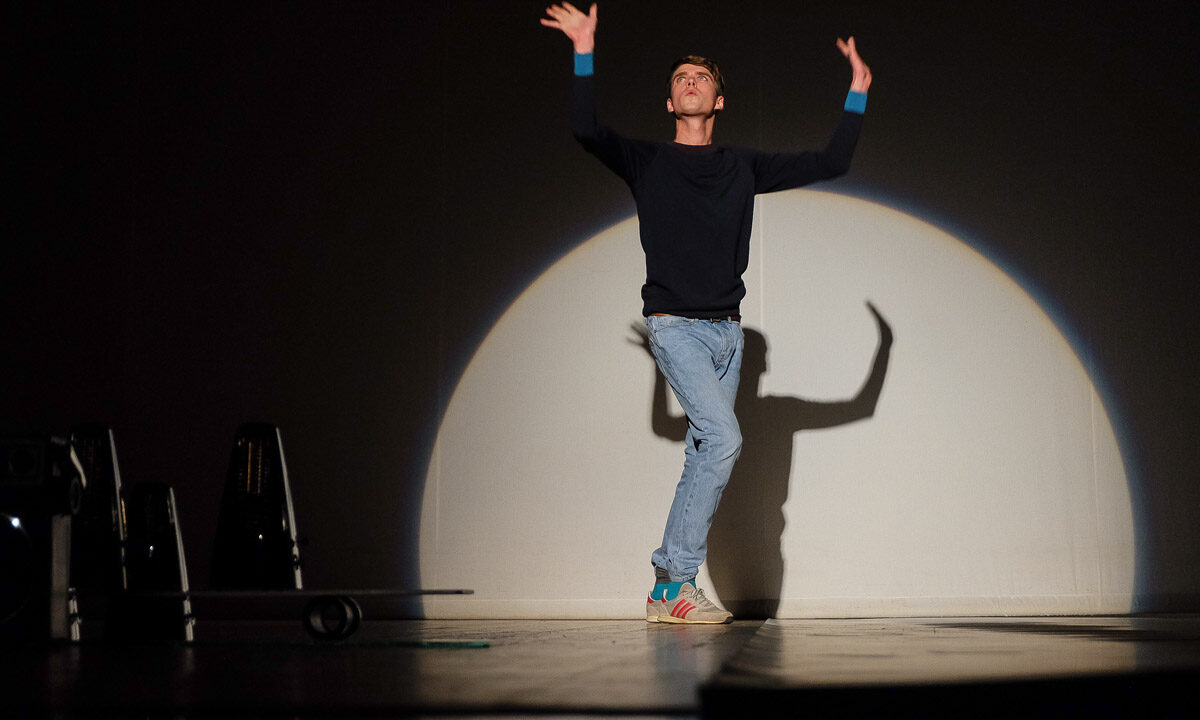
“Rhythm is a Dancer”.
Author, on stage: Henri Hütt, sound design by Algorütmid, light design by Villu Konrad, stylistics Kaie Olmre, photo: Hannes Aasamets.
Premiere 27.11 at Kanuti Gildi SAAL.
It is often difficult to remain calm about dance performances. The anxiety mainly stems from a prejudice about one’s own abilities of interpretation and understanding. Viewers often hesitate whether the movement on the stage is narrative and if the viewers should have a clear understanding of what is going on. This creates a feeling of protest towards the performer – you start to think he is not sure what he is doing there himself. Of course it isn’t true, probably the person on the stage is the only one who really knows what it’s all about. And people close to him – his colleagues – come quite close to understanding his intentions. The viewer, however, is left with a feeling of dissatisfaction in his or her efforts to “really understand” the performance.
Hütt’s “Rhythm is a Dancer” doesn’t demand much in terms of explanation: his premise is clear, the show is divided into distinguishable parts, each of which is polished, precise and minimalist. Through his own experiences Hütt talks about the sense of rhythm that touches all human beings, starting with the pattern of repetition in the world around us and ending with a rhythm that is central and individual – the heartbeat. The show is not encumbered by symbols, which would create a mess where the viewer might feel overwhelmed. Hütt asks in his show: is it possible to make the whole audience breathe together, make their hearts beat to the same rhythm? An interesting question and worth a search for an answer. However, if it is the dance performance’s (as well as every other performance’s) mission to make the viewer think, feel, respond, then wouldn’t a more important question first be: is it possible for a performer to make the audience’s heart beat at all?
In the show Hütt has decided not to just use a rhythm and a catchy visual, which would probably be the easiest way to “buy off” the audience. He has created a visually neutral zero space, where he analyses the essence of rhythm. It sounds profound, but inevitably you get the feeling as if you were reading the entry “rhythm” in the dictionary and examples of the contexts it can be used in. Understandably Hütt has spent a lot of time deliberating on the subject, so perhaps this is why the performance tastes more like a meatless bone? The analogy may seem harsh, but what I mean is that the show is like a skeleton, which is interesting to look at, but which doesn’t make my heart beat in a special way. The ideas and information are processed, separated from the context and appear before us in a too refined way. It seems like the best and most exciting part of the research and the process of the production is the one the viewer doesn’t get to see.
A person’s heartbeat is probably the most intimate and personal sound in the world. It is not directly regulated, for it can act in a way unexpected even to ourselves. In the last part of the show Hütt has reached the stage where he shares his heartbeats with the audience and has arrived at the core of the question he is intrigued by – how to move according to one’s own heartbeat? It is a beautiful and profound idea and feels like a question without a beginning and an end. There is the body, which moves listening to its inner rhythm, which in turn changes due to physical movements.
Everything is subject to interpretation and analysis. Even the kind of (dance) performances that really screw you up. Sometimes it is even possible to understand the performance. But it is inevitable that only certain situations and people make our hearts change their rhythm involuntarily. It doesn’t depend on our wishes or will. In a way “Rhythm is a Dancer” managed to prove this point.
